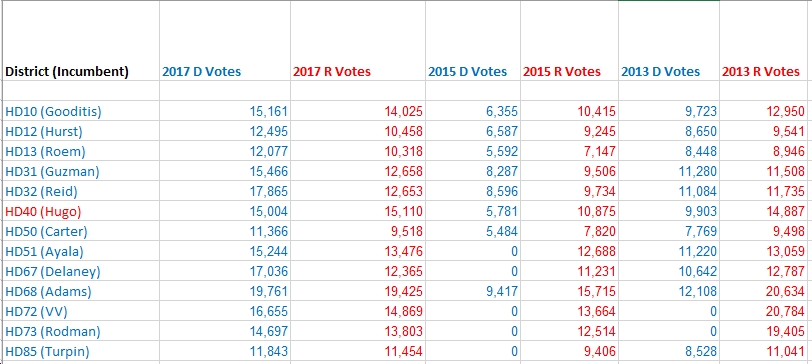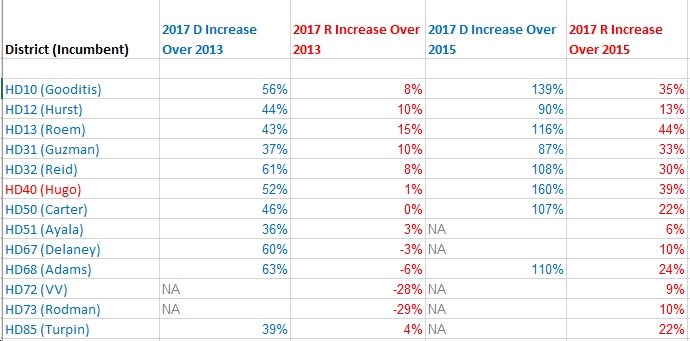I was chatting with a Virginia Dem elected official this morning, someone whose analysis of elections/politics I really respect, and they were telling me they’re nervous heading into the 2019 House of Delegates elections. According to my source, House Dems could have trouble defending several of our freshmen this year, the “off/odd election year” in Virginia, in which there’s no federal race AND no statewide race for governor/LG/AG on the ballot.
So basically, this year, the “top of the ticket” is going to be some high-profile county races (e.g., for Fairfax County Board Chair, Loudoun County Board Chair, PW County Board Chair), a few State Senate races in competitive districts, and other than that the House of Delegates races. The question isn’t WHETHER voter turnout in 2019 will “drop off” from the 2017 gubernatorial election year, but by HOW MUCH – both overall and relatively (e.g., how symmetric/asymmetric) between Rs and Ds.
Anyway, I was curious what different scenarios might look like, so I crunched some numbers for key House of Delegates districts (I avoided districts that will probably be changing due to the “Bethune-Hill” racial packing case), which you can see below, and looked at how that might impact results. Of course, it’s quite possible that Republicans won’t show up in November, perhaps because they’re demoralized, and that Democratic “dropoff” from the last gubernatorial year won’t be as bad as it’s been historically in Virginia. It’s also quite possible that Chaz Nuttycombe’s predictions (“not a matter of whether Democrats are flipping the chamber this November…it’s whether Democrats will get to 60 seats”) will be proven correct. But just to see what COULD happen given a few different “dropoff” scenarios, I pulled together a few tables – see below (click to enlarge). Highlights that jumped out at me include:
- First off, note how much larger Dem turnout was in 2017 compared to 2015 (“off/odd-year”) and 2013 (gubernatorial year). For instance, HD10 (currently represented by Del. Wendy Gooditis) saw 15,161 votes in 2017, up 56% from just 9,723 in 2013 and up 139% from only 6,355 in 2015. Or look at HD13 (Del. Danica Roem), which had 12,077 Dem votes in 2017, up 116% from just 5,592 in 2015. HD50 (Del. Lee Carter) is another good example, with 11,366 Dem votes in 2017, up 107% from just 5,484 in 2015.
- In sharp contrast, you can see that Republican turnout has been MUCH steadier over the years. In HD10, for instance, Republican turnout was 14,025 in 2017, up only slightly from 12,950 in 2013 and from 10,415 in 2015. So, while Dem turnout in HD10 more than doubled in 2017 compared to 2015, Republican turnout in HD10 was up just 35% from 2015 and up only 8% from 2013. In HD13, Dem turnout in 2017 was also more than double 2015 turnout and up nearly 50% from 2013, while Republican turnout was up just 44% from 2015 and 15% from 2013.
- Clearly, Dem turnout went wild in 2017, with massive anti-Trump energy fueling it, while Republican turnout wasn’t much changed from the last gubernatorial election year of 2013. The bottom line is that Republicans are much, much steadier, more regular voters than Democrats, at least when it comes to Virginia elections. And historically, that has usually hurt Democrats badly in “off/odd” years. The question is, will it do so again in the “off/odd” election year of 2019? If we want to take back the House of Delegates, we’d better work our butts off to make sure it doesn’t!
- I played with some turnout scenarios, such as if Dem turnout in 2019 is around the midpoint of 2013 and 2017 turnout; if it drops 10%/20%/30% from 2017; if it actually goes UP 10% from 2017 (very very unlikely, but just for fun more than anything); and if it goes up 10% or 30% from 2015. In all these cases, I assumed – for simplicity’s sake – that R turnout is unchanged. I’m not saying R turnout WILL be unchanged, just that this is an easy way to look at the RELATIVE turnout changes by Ds and Rs. One could just as easily assume that R turnout drops x%, and that D turnout drops 10%/20%/30%+x% or whatever. Fun with numbers/math, in other words – heh.
- What would have happened if Dem turnout in 2017 had been the same as it was in the previous gubernatorial election year (2013)? Basically, Republicans would have won all those competitive districts we actually ended up winning. In short, Dems picked up 15 seats in 2017 because of a massive, historically unprecedented surge of Dem votes, while Republican turnout didn’t change that much from historical norms. Again, the question is what happens to Dem turnout in 2019 – does it “regress to the mean” so to speak, or does it continue its Trump-era surge? That’s the “ballgame” right there, pretty much.
- What happens it Dem turnout in 2019 drops off to the midpoint of 2013 and 2017, while Republican turnout stays the same as 2017? In short, we get our butts kicked. Same thing if Dem turnout drops 30% from 2017 while Republican turnout stays the same as 2017. If Dem turnout drops 20% from 2017 while Republican turnout doesn’t change, it’s still VERY bad, although we do manage to hold on to HD32 (Reid) and HD67 (Delaney) in that scenario. If Dem turnout drops 10% from 2017 while Republican turnout doesn’t change, it’s a lot better, but we still lose several freshmen, which obviously wouldn’t be good. And finally, what happens if Dem turnout actually INCREASES from 2017 while Republican turnout stays the same? In that case, Dems would kick butt, including picking up HD40 (Republican incumbent Del. Tim Hugo). Again, remember that these numbers are all relative; I am *not* expecting turnout INCREASES from 2017; looking at it this way is just a simplifying way to consider relative changes in D and R turnout.
- Finally, looking at things relative to 2015, which intuitively makes more sense (since it’s the previous “off/odd” election year), you can see that Dems lose badly if we only increase our turnout 10% from 2015 while Republican turnout stays the same from that base. Even if Dems increase turnout 30% from 2015, if Republican turnout stays the same from 2015 we run into a lot of problems. In short, what we need to do in 2019 is once again – just as we did in 2017 – completely bust the historical precedents for voter “dropoff.” Not as much as we did in 2017, of course, since Republican turnout will drop off from the gubernatorial election year. But given that Republican turnout is relatively steady, we’re going to have to crank it up a few notches in 2019 from previous “off/odd” election year Dem turnout if we want to hold onto all our seats – and even pick up ones like Del. Tim Hugo’s. I think we can do this, I’m just not sure it will actually happen, since we haven’t really seen it historically. But yeah, we ARE still in the anti-Trump backlash phase. The questions are: 1) will that be the case in November; and 2) how large will it be this November? If we want to take back the House of Delegates, we’d better hope the answer to #1 is a resounding YES and that the answer to #2 is “very large!”
P.S. One thing we could REALLY use in 2019 is for the Democratic presidential candidates to *really* focus some of their energies on helping Virginia Democrats in this November’s elections. Personally, I’m going to be keeping track and mentally “scoring” the candidates – up or down – based on how much (or little) they help out here in Virginia this year. We are, after all, the only state in 2019 with elections that could result in flipping the state legislature…seems pretty important to me!







![Video: Former Eastern District of VA Federal Prosecutor Gene Rossi Asks, “Is Donald Trump going to be the lead counsel in that prosecution [of Jim Comey] and do the opening, closing and rebuttal? I pray that he does!”](https://bluevirginia.us/wp-content/uploads/2025/09/rossiedva-238x178.jpg)









![Video: Sen. Tim Kaine on “Meet the Press” Says DoJ Not Complying with the Law on Release of ALL the Epstein Files, But Argues “I think [impeachment/contempt for DoJ officials is] premature”](https://bluevirginia.us/wp-content/uploads/2025/12/kainemtp1221-100x75.jpg)

![Video: Rep. James Walkinshaw (D-VA11) Says “It’s enormously frustrating,” as “the law is clear…the full files were supposed to be released [yesterday] and the Trump administration is not in compliance with that law”](https://bluevirginia.us/wp-content/uploads/2025/12/walk1219-100x75.jpg)